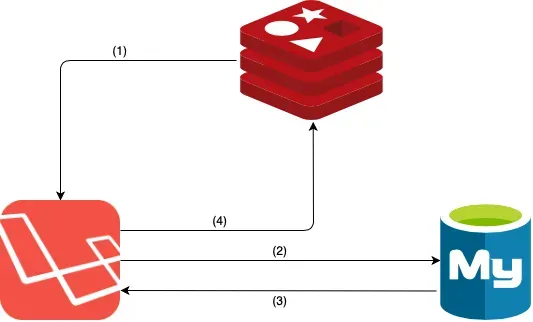Implementing Distributed Caching with Laravel Redis Cluster
Author: Hocine Mechouh
Published on: March 30, 2024
Implementing effective distributed caching is crucial for large-scale Laravel applications. This comprehensive guide explores advanced patterns for implementing Redis Cluster in Laravel, focusing on high availability, fault tolerance, and optimal cache performance.

1. High-Availability Redis Cluster Manager
Let’s start with a robust Redis Cluster implementation that ensures high availability and fault tolerance:
namespace App\Services\Cache;
use Illuminate\Support\Facades\Log;
use RedisClusterException;
class RedisClusterManager
{
private array $nodes = [];
private array $options;
private ?\RedisCluster $cluster = null;
private int $retryAttempts;
public function __construct(array $config)
{
$this->nodes = $config['nodes'] ?? [];
$this->options = $config['options'] ?? [];
$this->retryAttempts = $config['retry_attempts'] ?? 3;
}
public function connect(): \RedisCluster
{
if ($this->cluster) {
return $this->cluster;
}
$attempt = 1;
while ($attempt <= $this->retryAttempts) {
try {
$this->cluster = new \RedisCluster(
null,
$this->formatNodes(),
$this->options['timeout'] ?? 0.5,
$this->options['read_timeout'] ?? 0.5,
true,
$this->options['password'] ?? null
);
$this->configureCluster();
return $this->cluster;
} catch (RedisClusterException $e) {
Log::error('Redis cluster connection failed', [
'attempt' => $attempt,
'exception' => $e->getMessage()
]);
if ($attempt === $this->retryAttempts) {
throw $e;
}
sleep(pow(2, $attempt - 1)); // Exponential backoff
$attempt++;
}
}
throw new RedisClusterException('Failed to connect to Redis cluster');
}
private function formatNodes(): array
{
return array_map(function ($node) {
return sprintf('%s:%d', $node['host'], $node['port']);
}, $this->nodes);
}
private function configureCluster(): void
{
if (isset($this->options['prefix'])) {
$this->cluster->setOption(\Redis::OPT_PREFIX, $this->options['prefix']);
}
if (isset($this->options['serializer'])) {
$this->cluster->setOption(
\Redis::OPT_SERIALIZER,
$this->options['serializer']
);
}
}
}Key Features Explained
-
Robust Connection Handling
- Implements retry logic with exponential backoff
- Proper error logging and exception handling
- Connection pooling through singleton pattern
-
Flexible Configuration
- Supports multiple node configurations
- Customizable timeouts and connection parameters
- Optional key prefix and serialization settings
2. Advanced Cache Repository with Fault Tolerance
This implementation provides a higher-level abstraction for cache operations with built-in fault tolerance:
namespace App\Services\Cache;
use Closure;
use Illuminate\Support\Facades\Log;
use App\Exceptions\CacheException;
class ResilientCacheRepository
{
private const DEFAULT_TTL = 3600; // 1 hour
private bool $fallbackToDatabase = true;
public function __construct(
private RedisClusterManager $redis,
private DatabaseRepository $database,
private CacheCircuitBreaker $circuitBreaker
) {}
public function remember(string $key, Closure $callback, ?int $ttl = null): mixed
{
try {
return $this->circuitBreaker->execute(function () use ($key, $callback, $ttl) {
$value = $this->get($key);
if ($value !== null) {
return $value;
}
$value = $callback();
$this->put($key, $value, $ttl ?? self::DEFAULT_TTL);
return $value;
});
} catch (CacheException $e) {
Log::warning('Cache operation failed, falling back to database', [
'key' => $key,
'exception' => $e->getMessage()
]);
if ($this->fallbackToDatabase) {
return $callback();
}
throw $e;
}
}
public function tags(array $tags): TaggedCache
{
return new TaggedCache(
$this->redis->connect(),
$tags,
$this->circuitBreaker
);
}
public function atomic(string $key, Closure $callback, int $ttl = 5): mixed
{
$lockKey = "lock:{$key}";
$redis = $this->redis->connect();
try {
$acquired = $redis->set($lockKey, 1, ['NX', 'EX' => $ttl]);
if (!$acquired) {
throw new CacheException('Failed to acquire lock');
}
return $callback();
} finally {
$redis->del($lockKey);
}
}
protected function get(string $key): mixed
{
$redis = $this->redis->connect();
$value = $redis->get($key);
if ($value === false && $redis->getLastError()) {
throw new CacheException($redis->getLastError());
}
return $value !== false ? unserialize($value) : null;
}
protected function put(string $key, mixed $value, int $ttl): bool
{
$redis = $this->redis->connect();
return $redis->setex($key, $ttl, serialize($value));
}
}Advanced Features Breakdown
-
Circuit Breaker Integration
- Prevents cascade failures
- Automatic recovery after cooling period
- Graceful degradation to database
-
Atomic Operations
- Distributed locking mechanism
- Prevents race conditions
- Automatic lock release
-
Smart Caching Strategies
- Cache-aside pattern implementation
- Automatic serialization handling
- Configurable TTL management
3. Cache Invalidation and Consistency
Here’s a sophisticated implementation for handling cache invalidation:
namespace App\Services\Cache;
class CacheInvalidationManager
{
private array $pendingInvalidations = [];
public function __construct(
private ResilientCacheRepository $cache,
private EventDispatcher $events
) {}
public function invalidate(string $key): void
{
$this->pendingInvalidations[] = $key;
if (!$this->isInTransaction()) {
$this->processPendingInvalidations();
}
}
public function transaction(Closure $callback): mixed
{
$this->beginTransaction();
try {
$result = $callback();
$this->processPendingInvalidations();
return $result;
} catch (Exception $e) {
$this->pendingInvalidations = [];
throw $e;
}
}
private function processPendingInvalidations(): void
{
if (empty($this->pendingInvalidations)) {
return;
}
$this->cache->atomic('cache:invalidation', function () {
foreach ($this->pendingInvalidations as $key) {
$this->cache->forget($key);
$this->events->dispatch(
new CacheInvalidated($key)
);
}
});
$this->pendingInvalidations = [];
}
private function beginTransaction(): void
{
$this->transactionLevel++;
}
private function isInTransaction(): bool
{
return $this->transactionLevel > 0;
}
}Key Features Explained
-
Transactional Invalidation
- Groups multiple invalidations
- All-or-nothing semantics
- Event broadcasting for consistency
-
Race Condition Prevention
- Atomic operations
- Distributed locking
- Queue-based processing
Best Practices and Considerations
-
Performance Optimization
- Use batch operations when possible
- Implement proper serialization
- Monitor memory usage
- Set appropriate TTLs
-
Error Handling
- Implement retry mechanisms
- Use circuit breakers
- Log failures appropriately
- Provide fallback mechanisms
-
Monitoring
- Track hit/miss ratios
- Monitor memory usage
- Watch for network issues
- Set up alerts for failures
Common Pitfalls to Avoid
-
Cache Stampede
- Problem: Multiple concurrent requests trying to regenerate the same cached item
- Solution: Implement lock mechanisms or cache warming
-
Memory Overuse
- Problem: Storing too much data or improper TTL settings
- Solution: Monitor memory usage and implement eviction policies
-
Network Issues
- Problem: Unreliable network connections affecting cache operations
- Solution: Implement proper timeout and retry mechanisms
Conclusion
Building a robust distributed caching system with Laravel Redis Cluster requires careful consideration of:
-
High Availability
- Fault tolerance
- Circuit breakers
- Fallback strategies
-
Data Consistency
- Atomic operations
- Transactional invalidation
- Event-driven updates
-
Performance
- Proper serialization
- Batch operations
- Memory management
Remember that while Redis Cluster provides powerful capabilities, it also introduces complexity. Always test thoroughly under various failure scenarios and monitor your system’s performance in production.